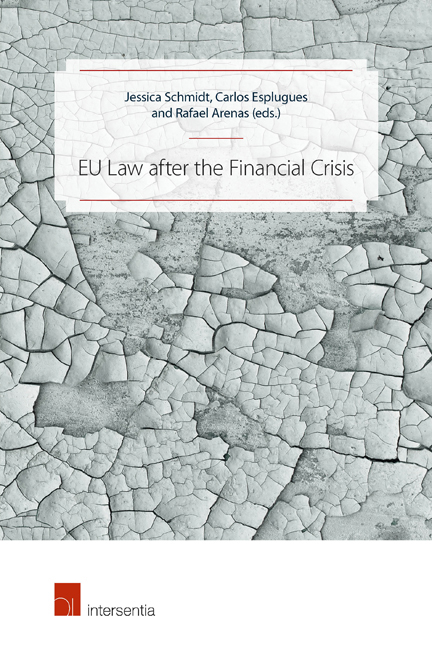Book contents
- Frontmatter
- Contents
- List of Abbreviations
- List of Authors
- Introduction
- PART I RESCUE MECHANISMS AND MONETARY POLICY
- PART II THE IMPACT OF THE FINANCIAL CRISIS ON THE BANKING SECTOR AND CAPITAL MARKETS
- PART III THE FINANCIAL CRISIS AND TAX LAW
- PART IV THE FINANCIAL CRISIS, CONSUMERS AND CONSUMER LAW
- PART V THE FINANCIAL CRISIS AND COMPETITION LAW
- PART VI THE FINANCIAL CRISIS, RESTRUCTURING AND INSOLVENCY LAW
- Universal versus Individual Transfers of Assets and Liabilities. A Conflict-of-Laws Perspective
- Financial Crisis and European Insolvency Law
- International Arbitration and vis attractiva concursus
- PART VII THE SOCIAL DIMENSION OF THE FINANCIAL CRISIS AND EU CITIZENSHIP
- PART VIII REFLECTIONS ON THE IMPACT OF THE FINANCIAL CRISIS ON THE GENERAL EUROPEAN LEGAL FRAMEWORK AND THE FUNDAMENTAL “EUROPEAN IDEA”
Financial Crisis and European Insolvency Law
from PART VI - THE FINANCIAL CRISIS, RESTRUCTURING AND INSOLVENCY LAW
Published online by Cambridge University Press: 13 December 2017
- Frontmatter
- Contents
- List of Abbreviations
- List of Authors
- Introduction
- PART I RESCUE MECHANISMS AND MONETARY POLICY
- PART II THE IMPACT OF THE FINANCIAL CRISIS ON THE BANKING SECTOR AND CAPITAL MARKETS
- PART III THE FINANCIAL CRISIS AND TAX LAW
- PART IV THE FINANCIAL CRISIS, CONSUMERS AND CONSUMER LAW
- PART V THE FINANCIAL CRISIS AND COMPETITION LAW
- PART VI THE FINANCIAL CRISIS, RESTRUCTURING AND INSOLVENCY LAW
- Universal versus Individual Transfers of Assets and Liabilities. A Conflict-of-Laws Perspective
- Financial Crisis and European Insolvency Law
- International Arbitration and vis attractiva concursus
- PART VII THE SOCIAL DIMENSION OF THE FINANCIAL CRISIS AND EU CITIZENSHIP
- PART VIII REFLECTIONS ON THE IMPACT OF THE FINANCIAL CRISIS ON THE GENERAL EUROPEAN LEGAL FRAMEWORK AND THE FUNDAMENTAL “EUROPEAN IDEA”
Summary
INTRODUCTION
Hardly any other area of law is as closely linked with financial crises as insolvency law. Without being too technical, it is possible to claim that insolvency law owes its very existence to the possibility of financial crises. In an ideal world, debtors can always discharge their debts, creditors are happy and so are debtors. However, reality closes in on them whenever a debtor loses the capacity to honour all his debts. In a creditors’ utopia, enslavement of, or at least prison for, the debtor would be the method of choice but is, for obvious reasons, banned by international law. In contrast, in a debtors’ utopia, an unconditional fresh start, free of all past debts, would certainly be preferred.
Modern insolvency law sets out to provide for a more balanced approach. It honours both the joint interest of the creditors to be paid and the debtor's individual interest to regain his economic freedom. In certain sectors, in particular the financial markets, public interests call for specific considerations. How these interests should be balanced is a political decision. Different legislators may provide for different solutions, and even the same legislator's solutions may differ over time. Crises frequently trigger legislative action. This chapter aims to outline how, speaking technically, the financial crisis of 2007 and subsequent years influenced the legal framework for insolvency law within the European Union. It will be suggested that the financial crisis has strongly promoted an extensive regulation of European insolvency law for the protagonists on financial markets (section 2). As for European insolvency law in general, the current development only seems to coincide with the aftermath of the crisis (section 3). Finally, although the financial crisis might be considered to have revealed a need for a specific state insolvency law, the European Union – at least its dominant Member States – seems to consider contractual approaches to be sufficient (section 4).
- Type
- Chapter
- Information
- EU Law after the Financial Crisis , pp. 227 - 236Publisher: IntersentiaPrint publication year: 2016



